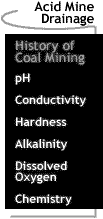

 |
Acid Mine Drainage: History of Coal Mining Wheeling's coal mining industry spans roughly 190 years. During that time span, billions of tons of coal have been extracted from virtually every hillside in and around the city. Many of Wheeling's coal mines were located along Big Wheeling Creek, Middle Wheeling Creek, and Little Wheeling Creek, as well as along many of Wheeling's lesser tributaries, such as Peters Run. The amount of coal mined from Wheeling's mineral-rich hills has fluctuated over time, since demand was tied to the economic performance of Wheeling's iron, steel, and other related industries. Conrad Cotts established Wheeling's first major coal mining site along Coal Street (now Kennedy Street). The mine was closed following a cave-in during 1815. Throughout the 1800s most of Wheeling's major mining sites were located on Wheeling Hill, Chapline Hill, and the Manchester slope in East Wheeling. Most of Wheeling's coal was consumed by private residents and the area's industries. However, some was exported to Pittsburgh and other areas of the country. During the 1800s and early to mid-1900s, most of Wheeling's industries owned and operated their own coal mines. "Reymann Brewing Co.," for example, "owned a Manchester Mine and all the major iron foundries except 'Top Mill' controlled mining interests" . . . in the Wheeling area.
Wheeling coal production decreased following WWII, but rebounded during the 1970s. From the 1970s until the late 1980s, Wheeling's coal industry mined record shattering amounts of coal. Since 1990, however, Wheeling's coal industries have virtually come to a halt. By 1995, there were no mining sites in Wheeling proper. [ Acid
Mine Drainage: History of
Coal Mining / pH / Conductivity / [ Sewage ] [ Agriculture ] [ Dredging ] [ Home ] [ Teacher Pages ] [ Modules & Activities ] |
HTML code by Chris Kreger
Maintained by ETE Team
Last updated November 10, 2004
Some images © 2004 www.clipart.com
Privacy Statement and Copyright © 1997-2004 by Wheeling Jesuit University/NASA-supported Classroom of the Future. All rights reserved.
Center for Educational Technologies, Circuit Board/Apple graphic logo, and COTF Classroom of the Future logo are registered trademarks of Wheeling Jesuit University.